人教版PEP小学英语六年级知识要点及习题总复习讲义.doc
新PEP小学英语六年级上册期中复习知识点总结及练习(打印版)

学校 班级 考号 姓名__________________________ 密 封 线PEP 人教版六年级英语上册 六年级上册期中复习要点Unit 1 How Do You Go There ?一. 知识点归纳 (一)、 词汇bike ( 自行车乘坐)公共汽车(脚)火车(怎样) 飞机(上学) 轮船)subway ( 地铁) ( 交通工具前加by , 表示乘坐但步行要用on foot )fifth 第五 remember 记住 find 找到 difference 不同 same 相同的 every 每个 所有的三会 country 国家 mean 意思是 drive 驾驶right 右边的 side 边 England 英国 Australia 澳大利亚 however 但是 left 左边的 if 如果 must 必须(二)、重点句型① 询问交通方式用疑问代词how⏹—— How do you go to school ? 你怎样去上学?—— I go to school on foot . 我走路去上学。
⏹—— How do you go to Canada ? 你怎么去加拿大。
—— I go by plane . 我坐飞机去。
⏹—— How does your father go to work ? 你父亲怎样去上班? —— He goes to work by subway . 他坐地铁去上班。
② 询问地点,用疑问代词where⏹ —— Where is your home ? 你家在哪里?—— It’s near the post office . 在邮局旁边。
⏹ —— Where are the teachers ? 老师们在哪儿? —— They are in the teacher’s office . 在老师的办公室。
人教版③问路⏹—— How can I get to Zhongshan Park ? 我怎么去中山公园?—— You can go by the No.1 bus.你可以坐一路车去。
人教版PEP小学六年级英语毕业总复习(词汇、语法、句型、题型、单词、更多).doc
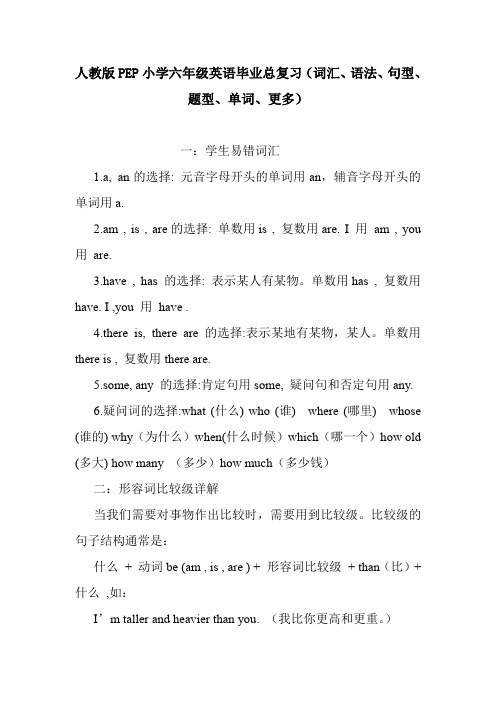
人教版PEP小学六年级英语毕业总复习(词汇、语法、句型、题型、单词、更多)一:学生易错词汇1.a, an的选择: 元音字母开头的单词用an,辅音字母开头的单词用a.2.am , is , are的选择: 单数用is , 复数用are. I 用am , you 用are.3.have , has 的选择: 表示某人有某物。
单数用has , 复数用have. I ,you 用have .4.there is, there are 的选择:表示某地有某物,某人。
单数用there is , 复数用there are.5.some, any 的选择:肯定句用some, 疑问句和否定句用any.6.疑问词的选择:what (什么) who (谁) where (哪里) whose (谁的) why(为什么)when(什么时候)which(哪一个)how old (多大) how many (多少)how much(多少钱)二:形容词比较级详解当我们需要对事物作出比较时,需要用到比较级。
比较级的句子结构通常是:什么+ 动词be (am , is , are ) + 形容词比较级+ than(比)+ 什么,如:I’m taller and heavier than you. (我比你更高和更重。
)An elephant is bigger than a tiger. (一只大象比一只老虎更大。
)形容词的比较级是在形容词的基础上变化而来的,它的变化规则是:①一般的直接在词尾加er ,如tall - taller , strong - stronger ,②以e结尾的,直接加r ,如fine – finer ,③以辅音字母加y结尾的,先改y为i再加er,如funny - funnier④双写最后的字母再加er,如big – bigger, thin – thinner ,hot – hotter☆注意☆比较的两者应该是互相对应的可比较的东西。
人教版PEP三起小学英语六年级上册知识点总结

人教版PEP三起小学英语六年级上册知识点总结Unit1 How can I get there?一、重点单词和短语Science科学museum博物馆post office邮局bookstore书店cinema电影院hospital医院tasty美味的,可口的London Eye伦敦眼stomach胃crossing十字路口turn left/turn right向左/右转go straight=walk straight直走next to紧挨着/与……相邻far from(离……远)near在……附近behind(在……后面)in front of(在……前面)between…and…(在…和…之间)二、重点句子1.How do you go to school? 你是怎样去上学的?2.where is the restaurant? 餐馆在哪里?3. Usually I go to school on foot. 我通常走路去上学。
4. Sometimes I go by bike. 有时候我骑自行车去。
5.问路之前,出于礼貌,我们要说“Excuse me”与后面的句子要用标点符号隔开。
6.Look at the traffic lights, remember the traffic rules. 看着交通灯,记住交通规则。
7.Stop at a red light.Wait at a yellow light. Go at a green light.红灯停。
黄灯等一等。
绿灯行。
8.Red means stop, yellow means wait, green means go. 红色的意思是停止,黄色的意思是等待,绿色的意思是通行。
9.How can I get to the park? 我该怎样到达公园呢?10.You can go by the No.15 bus. 你可以坐15路公交车去。
人教版(PEP)小学英语六年级上册知识点归纳总结
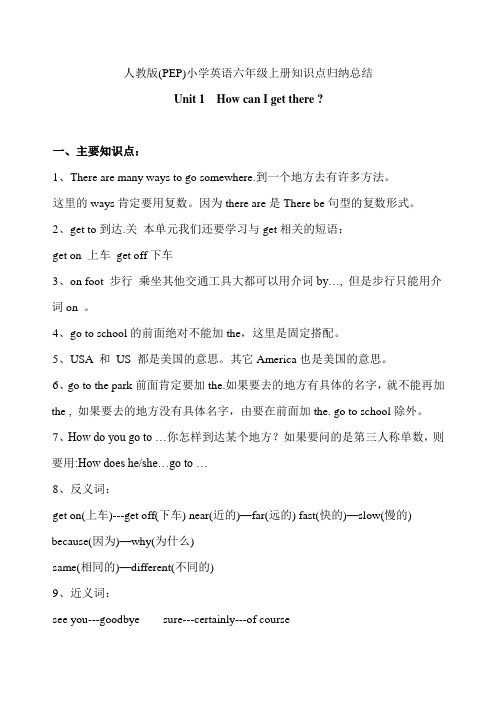
人教版(PEP)小学英语六年级上册知识点归纳总结Unit 1 How can I get there ?一、主要知识点:1、There are many ways to go somewhere.到一个地方去有许多方法。
这里的ways肯定要用复数。
因为there are是There be句型的复数形式。
2、get to到达.关本单元我们还要学习与get相关的短语:get on 上车get off下车3、on foot 步行乘坐其他交通工具大都可以用介词by…, 但是步行只能用介词on 。
4、go to school的前面绝对不能加the,这里是固定搭配。
5、USA 和US 都是美国的意思。
其它America也是美国的意思。
6、go to the park前面肯定要加the.如果要去的地方有具体的名字,就不能再加the , 如果要去的地方没有具体名字,由要在前面加the. go to school除外。
7、How do you go to …你怎样到达某个地方?如果要问的是第三人称单数,则要用:How does he/she…go to …8、反义词:get on(上车)---get off(下车) near(近的)—far(远的) fast(快的)—slow(慢的) because(因为)—why(为什么)same(相同的)—different(不同的)9、近义词:see you---goodbye sure---certainly---of course10、频度副词:always 总是,一直usually 通常often经常sometimes 有时候never 从来不二、主要单词:museum博物馆bookstore书店cinema电影院turn 转弯hospital医院left向左post office 邮局science科学right向右straight笔直地crossing 十字路口三、习惯语搭配:post office邮局science museum科学博物馆pet hospital宠物医院Italian restaurant意大利餐馆Beihai Park北海公园Palace Museum故宫博物院go straight直走turn right/left右/左转next to挨着in front of...在...前面near the park在公园附近on Dongfang Street在东方大街上四、惯用表达式:by plane 坐飞机by ship 坐轮船on foot步行by bike 骑自行车by bus 坐公共汽车by train 坐火车traffic lights交通灯traffic rules交通规则Stop at a red light 红灯停Wait at a yellow light 黄灯等Go at a green light 绿灯行Excuse me 打扰一下Follow me, please!请跟着我!五、主要句子:How do you go to school你怎么去上学?Usually I go to school on foot. Sometimes I go by bus.通常我步行去上学。
人教版PEP小学英语六年级上册单元知识点总结
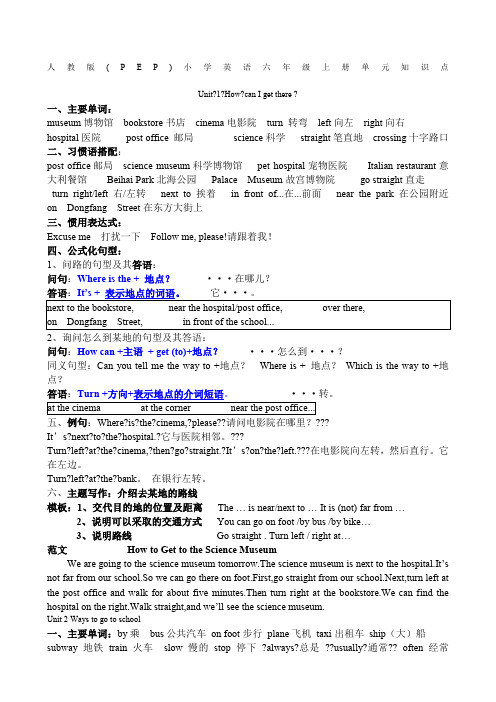
人教版(P E P)小学英语六年级上册单元知识点Unit?1?How?can I get there ?一、主要单词:museum博物馆bookstore书店cinema电影院turn 转弯left向左right向右hospital医院post office 邮局science科学straight笔直地crossing十字路口二、习惯语搭配:post office邮局science museum科学博物馆pet hospital宠物医院Italian restaurant意大利餐馆Beihai Park北海公园Palace Museum故宫博物院go straight直走turn right/left右/左转next to挨着in front of...在...前面near the park在公园附近on Dongfang Street在东方大街上三、惯用表达式:Excuse me 打扰一下Follow me, please!请跟着我!四、公式化句型:1、问路的句型及其答语:问句:Where is the + 地点?···在哪儿?答语:It’s + 表示地点的词语。
它···。
next to the bookstore, near the hospital/post office, over there,on Dongfang Street, in front of the school...2、询问怎么到某地的句型及其答语:问句:How can +主语+ get (to)+地点?···怎么到···?同义句型:Can you tell me the way to +地点?Where is + 地点?Which is the way to +地点?答语:Turn +方向+表示地点的介词短语。
PEP人教版小学英语六年级下册单元知识梳理总结(全册)

六年级下册单元知识点第一单元四会单词:tall—taller更高的short—shorter 更矮的strong—stronger更强壮的old—older 年龄更大的young—younger 更年轻的big—bigger更大的heavy—heavier 更重的long—longer 更长的thin—thinner 更瘦的small—smaller (体型)更小的四会句型: How tall are you? 你有多高?I’m 164 cm tall. 我164 厘米高。
You’re shorter than me. 你比我矮。
You’re 4 cm taller than me.你比我高4厘米。
How heavy are you? 你有多重?I’m 48 kg. 我48千克。
应该掌握的知识点:1、表示两者之间有所比较时,句子中的形容词要用比较级形式。
形容词变为比较级的变化规则:(1)一般情况下,在形容词的词尾直接加er。
如: tall—taller short—shorter.(2)以字母e结尾的形容词,在词尾直接加r,如:nice—nicer. late—later (3)以重读闭音节结尾,且结尾只有一个辅音字母的词,先双写这个辅音字母,再加er.如:big—bigger thin—thinner fat—fatter (4)以辅音字母加y结尾的双音节形容词,先变y为i , 再加er。
如:easy—easier heavy—heavier funny—funnier.形容词比较级的变化口诀:原级变为比较级,通常er加上去。
若是结尾辅元辅,辅音双写要牢记。
辅音加y结尾时,把y变i 是必须。
原级若以e结尾,直接加r不后悔。
2、部分形容词比较级的不规则变化:good—better well—better bad—worse badly—worse many—more much—more little—less far—farther3、同义句:How tall are you?==What’s your height?How heavy are you?==What’s your weight?4、以How开头的问句(仅限小学阶段):How are you? 问身体状况。
pep小学英语六年级上册unit1复习资料及复习题
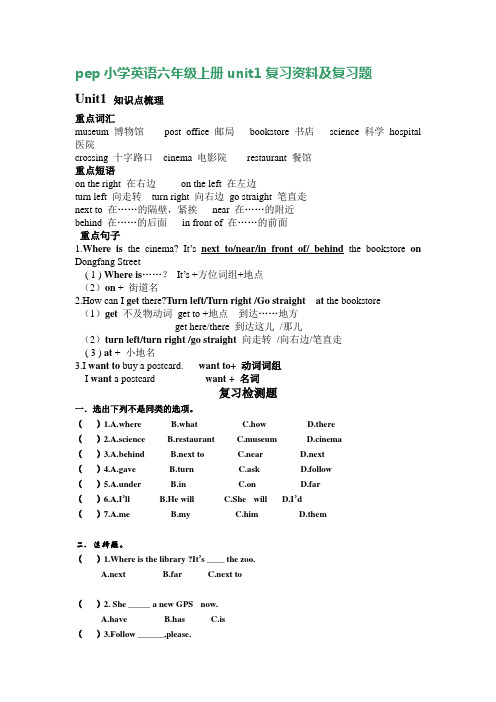
pep小学英语六年级上册unit1复习资料及复习题Unit1 知识点梳理重点词汇museum 博物馆post office 邮局bookstore 书店science 科学hospital 医院crossing 十字路口cinema 电影院restaurant 餐馆重点短语on the right 在右边on the left 在左边turn left 向走转turn right 向右边go straight 笔直走next to 在……的隔壁,紧挨near 在……的附近behind 在……的后面in front of 在……的前面重点句子1.Where is the cinema? It’s next to/near/in front of/ behind the bookstore on Dongfang Street( 1 ) Where is……?It’s +方位词组+地点(2)on + 街道名2.How can I get there?Turn left/Turn right /Go straight at the bookstore(1)get不及物动词get to +地点到达……地方get here/there 到达这儿/那儿(2)turn left/turn right /go straight 向走转/向右边/笔直走( 3 ) at + 小地名3.I want to buy a postcard. want to+ 动词词组I want a postcard want + 名词复习检测题一.选出下列不是同类的选项。
()1.A.where B.what C.how D.there()2.A.science B.restaurant C.museum D.cinema()3.A.behind B.next to C.near D.next()4.A.gave B.turn C.ask D.follow()5.A.under B.in C.on D.far()6.A.I’ll B.He will C.She will D.I’d()7.A.me B.my C.him D.them二.选择题。
(完整版)人教版(PEP)小学英语六年级上册复习资料
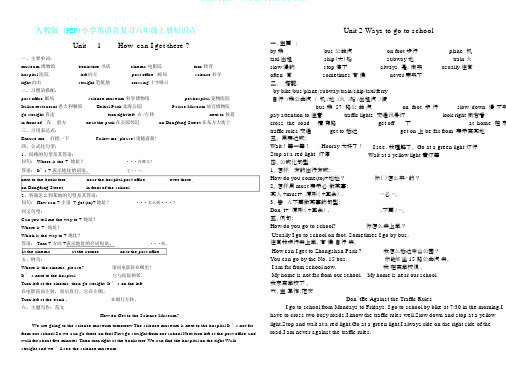
人教版 (PEP)小学英语总复习六年级上册知识点Unit1How can I get there ?一、主要单词:museum 博物馆bookstore 书店cinema 电影院turn 转弯hospital 医院left 向左post office邮局science 科学right 向右straight 笔挺地crossing 十字路口二、习惯语搭配:post office 邮局science museum 科学博物馆pet hospital 宠物医院Italian restaurant 意大利餐馆Beihai Park 北海公园Palace Museum 故宫博物院go straight 直走turn right/left 右 /左转next to 挨着in front of... 在 ...前方near the park 在公园邻近on Dongfang Street 在东方大街上三、习用表达式:Unit 2 Ways to go to school一、主要:by 乘bus 公共汽on foot 步行plane 机taxi 出租ship(大)船subway 地train 火slow 慢的stop 停下always 是,向来usually 往常often 常sometimes 有候never 素来不二、搭配:by bike/bus/plane/subway/train/ship/taxi/ferry自行 /乘公共汽 / 机 /地 /火 /船 /出租汽 /渡bus 乘 57 路公共汽on foot 步行slow down 慢下来pay attention to 注意traffic lights 交通讯号灯look right 向右看cross the road横穿路get off下at home 在家traffic rules 交通get to 抵达get on 上be far from⋯表示离某地Excuse me打搅一下Follow me, please! 请随着我!四、公式化句型:1、问路的句型及其答语:问句: Where is the + 地址?···在哪儿?答语: It’s + 表示地址的词语。
人教PEP版小学英语六年级上册知识点单元复习汇总
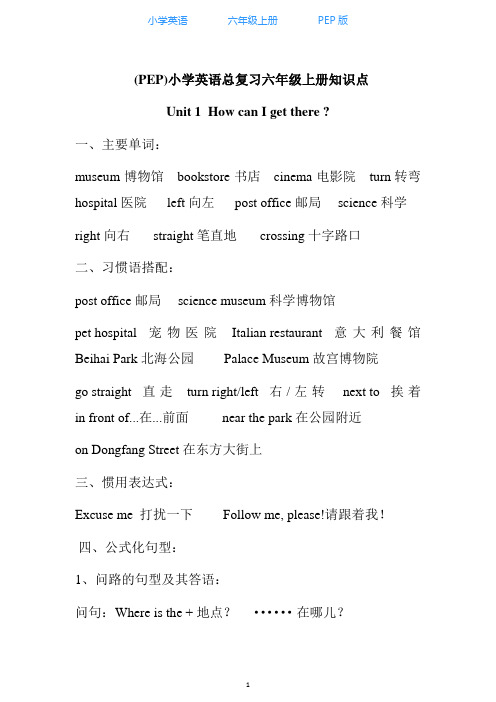
(PEP)小学英语总复习六年级上册知识点Unit 1 How can I get there ?一、主要单词:museum博物馆 bookstore书店 cinema电影院 turn 转弯hospital医院 left向左 post office 邮局 science科学right向右 straight笔直地 crossing十字路口二、习惯语搭配:post office邮局 science museum科学博物馆pet hospital宠物医院 Italian restaurant意大利餐馆Beihai Park北海公园Palace Museum故宫博物院go straight直走 turn right/left右/左转next to挨着in front of...在...前面near the park在公园附近on Dongfang Street在东方大街上三、惯用表达式:Excuse me 打扰一下 Follow me, please!请跟着我!四、公式化句型:1、问路的句型及其答语:问句:Where is the + 地点?······在哪儿?答语:It's + 表示地点的词语(next to the bookstore, near the hospital/post office, over there,on Dongfang Street, in front of the school... )2、询问怎么到某地的句型及其答语:问句:How can +主语 + get (to)+地点?·····怎么到·····?同义句型: Can you tell me the way to +地点?Where is + 地点? Which is the way to +地点?五、例句:Where is the cinema, please? 请问电影院在哪里?It's next to the hospital. 它与医院相邻。
人教版(PEP)小学英语六年级上册各单元知识点归纳(三年级起点)
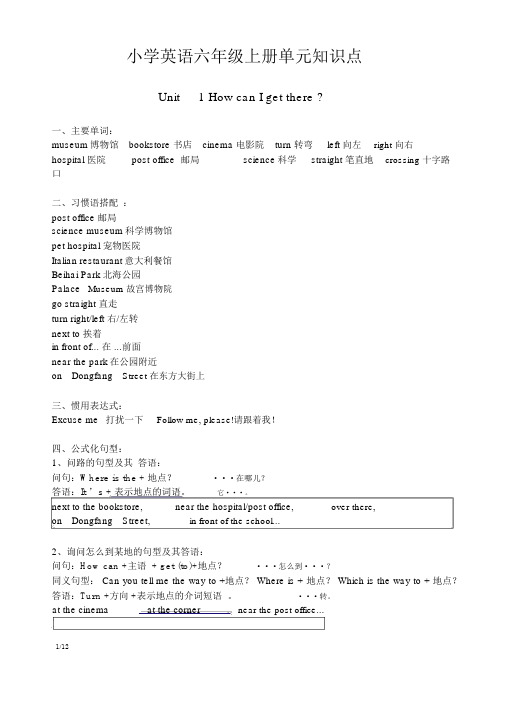
小学英语六年级上册单元知识点Unit 1 How can I get there ?一、主要单词:museum博物馆bookstore 书店cinema 电影院turn 转弯left 向左right 向右hospital 医院post office 邮局science科学straight 笔直地crossing 十字路口二、习惯语搭配:post office 邮局science museum科学博物馆pet hospital 宠物医院Italian restaurant意大利餐馆Beihai Park 北海公园Palace Museum 故宫博物院go straight 直走turn right/left 右/左转next to 挨着in front of... 在 ...前面near the park在公园附近on Dongfang Street 在东方大街上三、惯用表达式:Excuse me打扰一下Follow me, please!请跟着我!四、公式化句型:1、问路的句型及其答语:问句:Where is the + 地点?···在哪儿?答语:It ’s + 表示地点的词语。
它···。
next to the bookstore,near the hospital/post office,over there,on Dongfang Street,in front of the school...2、询问怎么到某地的句型及其答语:问句:How can +主语 + get (to)+地点?···怎么到···?同义句型: Can you tell me the way to +地点? Where is + 地点? Which is the way to + 地点?答语:Turn +方向 +表示地点的介词短语。
新PEP六年级英语总复习及练习精选全文完整版

可编辑修改精选全文完整版六年级英语毕业总复习一单词名词动词形容词可数不可数原型进行式过去式第三人称单数原型比较级apple water do doing did does fat fatter(将来时、一般现在时)(一般现在时)单数复数apple apples一、定义:名词可以分为可数名词和不可数名词,不可数名词没有单复数,一律看作单数。
二、可数名词:分为单数和复数⑴单数:以元音音标a e i o u 开头的单数用an(一个),其他用a(一个)或者one +单数复数:some(一些)加复数或者不可数名词;或者大于1的具体数字+复数⑵可数名词单数→复数的变化规则:三、不可数名词:以下词为常为不可数名词,他们的复数形式就是他们本身。
water 水milk牛奶tea 茶rice米饭juice 果汁bread面包meat 肉四、人称代词:be 动词am , is , are的选择: 单数用is , 复数用are,I 用am , you 用are.练习题一、选择a或an或some.pen bag apple big applebananas orange books water二、写出下列各词的复数.watch _______ child _______ day________ foot________ book_______ sheep ______ box_______ peach______ man______fish _______ paper_______三、选择:1、There on the wall .They are very beautiful.A. are photoesB. are photos2、That’s book.A. anB. a3、There some in the river.A. are, fishesB. are ,fish4. Would you like _______ ,please?A. some watersB. some water5、Do you want to drink much ?A、a milkB、milk四、选择be(am is are ) 填空。
最新人教pep版英语六年级下册《小学英语总复习基础知识点与重点难点考点分析详解》精品完整打印版整理汇总
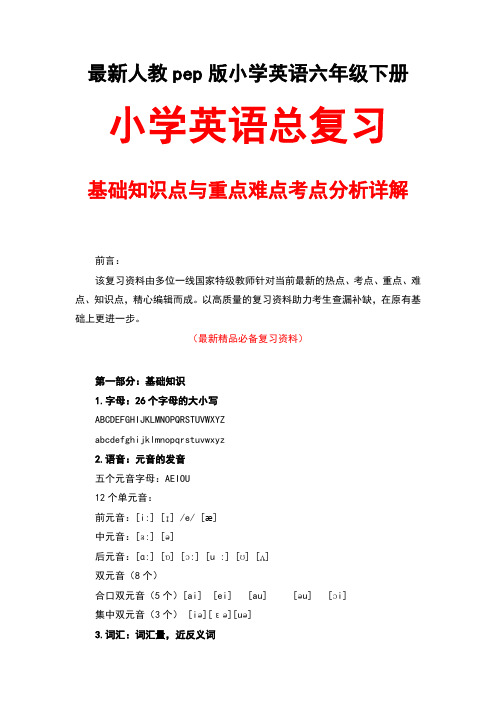
最新人教pep版小学英语六年级下册小学英语总复习基础知识点与重点难点考点分析详解前言:该复习资料由多位一线国家特级教师针对当前最新的热点、考点、重点、难点、知识点,精心编辑而成。
以高质量的复习资料助力考生查漏补缺,在原有基础上更进一步。
(最新精品必备复习资料)第一部分:基础知识1.字母:26个字母的大小写ABCDEFGHIJKLMNOPQRSTUVWXYZabcdefghijklmnopqrstuvwxyz2.语音:元音的发音五个元音字母:AEIOU12个单元音:前元音:[i:] [ɪ] /e/ [æ]中元音:[ɜ:] [ə]后元音:[ɑ:] [ɒ] [ɔ:] [u :] [ʊ] [ʌ]双元音(8个)合口双元音(5个)[ai] [ei] [au] [əu] [ɔi]集中双元音(3个) [iə][εə][uə]3.词汇:词汇量,近反义词4.句子:大小写,标点符号第二部分:语法知识1名词:名词单复数,名词的格(一)名词单复数一般情况,直接加-s,如:book-books, bag-bags, cat-cats, bed-beds 以s. x. sh. ch结尾,加-es,如:bus-buses, box-boxes, brush-brushes, watch-watches以“辅音字母+y”结尾,变y为i, 再加-es,如:family-families, strawberry-strawberries以“f或fe”结尾,变f或fe为v, 再加-es,如:knife-knives不规则名词复数:man-men, woman-women, policeman-policemen, policewoman-policewomen, mouse-micechild-children, foot-feet, tooth-teeth, fish-fish, people-people, Chinese-Chinese, Japanese-Japanese不可数名词的复数就是原型: paper, juice, water, milk, rice, tea(二)名词的格(1)有生命的东西的名词所有格:a) 单数后加’s 如: Lucy’s ruler my father’s shirtb) 以s 结尾的复数名词后加’如: his friends’ bagsc) 不以s 结尾的复数后加’s children’s shoes并列名词中,如果把’s加在最后一个名词后,表示共有, 如:Tom and Mike’s car 汤姆和迈克共有的小汽车要表示所有物不是共有的,应分别在并列名词后加’sTom’s and Mike’s cars 汤姆和麦克各自的小汽车(2)表示无生命东西的名词通常用“ of +名词”来表示所有关系:如:a picture of the classroom a map of China2冠词:不定冠词,定冠词种类(1)不定冠词:a / an a unit / an uncle元音开头的可数名词前用an :an egg / an apple / an orange / an eraser / an answer /an ID card / an alarm clock / an actor / an actress / an e-mail / an address / an event / an example / an opera /an houran old man / an interesting book / an exciting sport /an action movie / an art lesson /(2)定冠词:the the egg the plane定冠词的用法:特指某(些)人或某(些)物: The ruler is on the desk.复述上文提到的人或物:He has a sweater. The sweater is new.谈话双方都知道的人或物:The boys aren’t at school.在序数词前: John’s birthday is February the second.用于固定词组中: in the morning / afternoon / evening不用冠词的情况:专有名词前:China is a big country.名词前有定语:this , that , my , your , some, any , no 等:This is my baseball.复数名词表示一类人和事:Monkeys can’t swim. They are teachers.在节日,日期,月份,季节前:Today is Christmas Day. It’s Sunday.一日三餐前:We have breakfast at 6:30.球类棋类运动前:They often play football after class. He plays chess at home.* 但乐器前要用定冠词:I play the guitar very well.学科名称前:My favorite subject is music.在称呼或头衔的名词前:This is Mr Li.固定词组中:at noon at night by bus3代词、形容词、副词1).代词:人称代词,物主代词人称代词物主代词主格宾格第一人称单数I(我)memy(我的)复数we(我们)usour(我们的)第二人称单数you(你)youyour(你的)复数you(你们)youyour(你们的)第三人称单数he(他)himhis(他的)she(她)herher(她的)it(它)itits(它的)复数they(他们/她们/它们)themtheir(他们的/她们的/它们的)2).形容词,副词:比较级,最高级(一)、形容词的比较级1、形容词比较级在句子中的运用:两个事物或人的比较用比较级,比较级后面一般带有单词than。
PEP新版,小学英语六年级上下册,复习归纳.doc

星期 (week):
Sunday (Sun.)
星期日
Monday (Mon.)
星期一
Tuesday (Tue ? ) 星期二
Wednesday(Wed.) Thursday(Thur ? )
星期三 星期四
Friday (Fri. )
Saturday (Sa t.) week
weekend
星期五 星期六
count to ten
深的 呼吸 做深呼吸
数数
数到十
--What ,s wrong?
Your father is 订 L Don, t be sad ? He should see a doctor this morning ? They' re afraid of him. The cat is angry with them ?
classmate pen pal
university
兄弟 姐妹 阿姨 舅舅、叔叔 儿子 表堂亲 儿童
朋友 同学 笔友 大学生
母
a)
grandfather(gTandp 爷爷、夕卜祖
父
a)
grandparents
(外)祖父 母
student principal
rob ot
校长 机器人
职业 (job):
工厂工人
邮递员 商人
police officer fisherman scientist
pilot coach
警察
渔民 科学家 飞行员
教练
Unit 5
一一 What does he do? --He , s a businessman. ——Where does he work?
PEP人教版小学英语6年级期末总复习(6年级上下册知识点汇总答案)
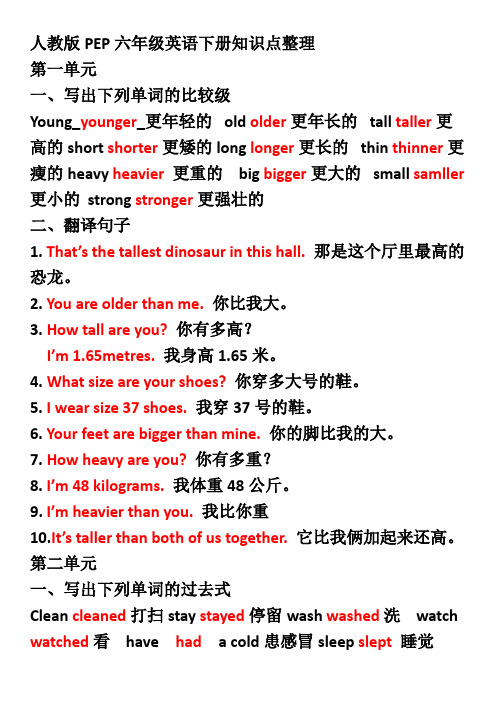
人教版PEP六年级英语下册知识点整理第一单元一、写出下列单词的比较级Young_younger_更年轻的 old older更年长的 tall taller更高的short shorter更矮的long longer更长的 thin thinner更瘦的heavy heavier更重的 big bigger更大的 small samller更小的 strong stronger更强壮的二、翻译句子1. That’s the tallest dinosaur in this hall. 那是这个厅里最高的恐龙。
2. You are older than me. 你比我大。
3. How tall are you?你有多高?I’m 1.65metres. 我身高1.65米。
4. What size are your shoes?你穿多大号的鞋。
5. I wear size 37 shoes.我穿37号的鞋。
6. Your feet are bigger than mine. 你的脚比我的大。
7. How heavy are you?你有多重?8.I’m 48 kilograms.我体重48公斤。
9.I’m heavier than you. 我比你重10.It’s taller than both of us together.它比我俩加起来还高。
第二单元一、写出下列单词的过去式Clean cleaned打扫stay stayed停留wash washed 洗 watch watched看 have had a cold患感冒sleep slept睡觉readread读 see saw看见二、翻译单词和短语(动词用过去式)last weekend上个周末yesterday昨天the day before yesterday前天cleaned my room打扫我的房间washed my clothes洗衣服stayed at home 呆在家里watched TV看电视went boating去划船read a book/ read books读书saw a film看电影had a cold感冒climbed mountains爬山cooked dinner做饭cooked noodles做面条三、翻译句子1. How was your weekend? 你周末过得怎么样?It was fine/OK/good, thanks.还不错,谢谢!2. What did you do last weekend?你上个周末干了什么?I stayed at home with your grandma.我和你奶奶待在家里。
2019-2020年人教版PEP小学英语六年级知识要点及习题总复习讲义

2019-2020年人教版PEP小学英语六年级知识要点及习题总复习讲义名词复数规则1.一般情况下,直接加-s,如:book-book s,bag-bag s,cat-cat s,bed-bed s2.以s.x.sh.ch结尾,加-es,如:bus-bus es,box-box es,peach-peach es, watch-watch es3.以“辅音字母+y”结尾,变y为i, 再加-es,如:famil y-famil ies, strawberr y-strawberr ies4.以“f或fe”结尾,变f或fe为v, 再加-es,(但有一个特例:roof→roofs)。
如: kni fe-kni ves lea f-lea ves wife-wivesthief-thieves wolf-wolves5.以“o”结尾的单词,如果有生命,加-es;如果没有生命,加-s。
如:①有生命:potato-potato es tomato-tomato esmango-mango es(芒果)hero-hero es(英雄) Negro- Negro es (黑人)②没生命:radio-radio s piano-piano s photo-photo szoo-zoo s6.不规则名词的复数变化:(一)完全不规则:m a n-m e n woman-women policeman-policemenpolicewoman-policewomen mouse-mice child-children f oo t-f ee t tooth-teeth goose-geese(二)单数复数同形:fish-fish sheep-sheep deer-deerpeople-peopleChinese-Chinese Japanese-Japanese 小练习:写出下列各词的复数I _______ him ______ this ______ her ______ watch _______ child ______ photo ______ diary______day______foot_______ book______ dress _____tooth______ sheep ______box_____ strawberry ________ leaf ____ potato ______ peach______ bus ______ man______ woman______ paper_______ juice______ water________ milk________ rice__________ tea__________一般现在时态一般现在时基本用法介绍1.一般现在时的功能1).表示事物或人物的特征、状态。
- 1、下载文档前请自行甄别文档内容的完整性,平台不提供额外的编辑、内容补充、找答案等附加服务。
- 2、"仅部分预览"的文档,不可在线预览部分如存在完整性等问题,可反馈申请退款(可完整预览的文档不适用该条件!)。
- 3、如文档侵犯您的权益,请联系客服反馈,我们会尽快为您处理(人工客服工作时间:9:00-18:30)。
山林小学人教版PEP山林小学英语六年级知识要点及习题总复习讲义名词复数规则1.一般情况下,直接加-s,如:book-book s,bag-bag s,cat-cat s,bed-bed s2.以s.x.sh.ch结尾,加-es,如:bus-bus es,box-box es,peach-peach es, watch-watch es3.以“辅音字母+y”结尾,变y为i, 再加-es,如:famil y-famil ies, strawberr y-strawberr ies4.以“f或fe”结尾,变f或fe为v, 再加-es,(但有一个特例:roof→roofs)。
如: kni fe-kni ves lea f-lea ves wife-wivesthief-thieves wolf-wolves5.以“o”结尾的单词,如果有生命,加-es;如果没有生命,加-s。
如:①有生命:potato-potato es tomato-tomato esmango-mango es(芒果)hero-hero es(英雄)Negro- Negro es (黑人)②没生命:radio-radio s piano-piano s photo-photo szoo-zoo s6.不规则名词的复数变化:(一)完全不规则:m a n-m e n woman-women policeman-policemenpolicewoman-policewomen mouse-mice child-children f oo t-f ee t tooth-teeth goose-geese(二)单数复数同形:fish-fish sheep-sheep deer-deerpeople-peopleChinese-Chinese Japanese-Japanese 小练习:写出下列各词的复数I _______ him ______ this ______ her ______ watch _______ child ______ photo ______ diary______day______foot_______ book______ dress _____tooth______ sheep ______box_____ strawberry ________ leaf ____ potato ______ peach______ bus ______ man______ woman______ paper_______ juice______ water________ milk________ rice__________ tea__________一般现在时态一般现在时基本用法介绍1.一般现在时的功能1).表示事物或人物的特征、状态。
如:The sky is blue.天空是蓝色的。
2).表示经常性或习惯性的动作。
如:I get up at six every day.我每天六点起床。
3).表示客观现实。
如:The earth goes around the sun.地球绕着太阳转。
2.一般现在时的构成1).be动词:主语+be(am,is,are)+其它。
如:I am a boy.我是一个男孩。
2).行为动词:主语+行为动词(+其它)。
(1)当主语为第一、第二人称或复数做主语时,谓动是原形。
如: I like English.我喜欢英语。
We study English.我们学习英语。
(2)当主语为第三人称(he, she,it)或单数时,要在动词后加"-s"或"-es"。
如: Mary like s Chinese.玛丽喜欢汉语。
山林小学3.一般现在时的变化A、be 动词的变化a.肯变否句,有be动词is\am\are\was\were,直接在is\am\are 动词后加not。
(注:我(I)用am,你(you)用are,is跟着他、她、它,单数和不可数名次用is,复数用are)如:He is not a worker.他不是工人。
b.肯变一般疑问句:Is\Am\are+主语+其它 ?(注:I\We变you,you 变I\we,其他人称不变)如:-I am a student.→-Are you a student?(注:一般疑问句有肯定和否定回答)-Yes,I am./ No,I'm not.c.特殊疑问句:疑问词(How\What\Where\When\How many...)+一般疑问句?(注:特殊疑问句直接回答)如:Where is my car? It’s under the chair.B.行为动词的变化。
a.肯变否定句:主语(第一、第二人称或复数)+ don't +动词原形(+其它)。
如:I don't like bread.当主语为第三人称单数时,要用doesn't构成否定句。
如:He doesn't often play computer games.b.肯变一般疑问句:Do( Does ) +主语+动词原形+其它?当主语为第一、第二人称或复数时用助动词Do构成一般疑问句。
如:- Do you often play football?- Yes, I do. / No, I don't.当主语为第三人称或单数时,要用Does构成一般疑问句。
如: - Does she go to work by bike?- Yes, she does. / No, she doesn't.c.特殊疑问句:疑问词+一般疑问句。
如:How does your father go to work?4.动词第三人称单数加"-s"或"-es"形式的变化规则1.一般情况下,直接加-s,如:play-plays, work-works.2.以s. x. sh. ch. o结尾,加-es,如:guess-guesses, wash-washes, watch-watches, go-goes,do-does3.以“辅音字母+y”结尾,变y为i, 再加-es,如:study-studies.4.以不发音的e结尾,直接加-s .如:make-makes.5.特殊词have-has.一般现在时用法专项练习:一、写出下列动词的第三人称单数drink ________ go ______ stay ______ make ______look _______ have_______ pass______ carry ______come______ watch______ plant_______ fly _______study_______ brush_______ do________ teach_______like_________二、用括号内动词的适当形式填空。
1.He often ________(have) dinner at home.2.Daniel and Tommy _______(be) in Class One.3.We _______(not watch) TV on Monday.4.Nick _______(not go) to the zoo on Sunday.5.______ they ________(like) the World Cup?6.What _______they often _______(do) on Saturdays?7._______ your parents _______(read) newspapers every day?8.The girl _______(teach) us English on Sundays.9.She and I ________(watch) TV together every evening.10.There ________(be) some water in the bottle.11.Mike _______(like) cooking.山林小学12.They _______(have) the same hobby.13.My aunt _______(look) after her baby carefully.14.You always _______(do) your homework well.15.I _______(be) ill. I’m staying in bed.16.She _______(go) to school from Monday to Friday.17.Liu Tao _______(do not) like PE.18.The child often _______(watch) TV in the evening.19.Su Hai and Su Yang _______(have) eight lessons this term.20.-What day _______(be) it today? - It’s Saturday.三、按照要求改写句子1.Daniel watches TV every evening.(改为否定句)___________________________________________________2.I am a teacher.(改为一般疑问句,并作否定回答)____________________________________________________3.She likes milk.(改为一般疑问句,作肯定回答)___________________________________________________4.Amy likes playing computer games.(改为一般疑问句,作否定回答)___________________________________________________5.We go to school every morning.(改为否定句)_______________________________________________________6.He speaks English very well.(改为否定句)___________________________________________________7.I like taking pictures on the holiday.(对划线部分提问) _______________________________________________________8.John comes from Canada.(对划线部分提问)___________________________________________________9.She is always a good student.(改为一般疑问句,作否定回答) _______________________________________________________ 10.Simon and Daniel like going skating.(改为否定句)___________________________________________________四、改错(划出错误的地方,将正确的写在横线上)1. Is your brother speak English?__________________________________________________2. Does he likes going fishing?__________________________________________________3. He likes play games after class.__________________________________________________4. Miss wei teachs us English.__________________________________________________5. She don’t do her homework on Sundays._________________________________________________现在进行时态1.现在进行时表示事情现在正在进行或发生的动作,也可表示当前一段时间内的活动或现阶段正在进行的动作。
